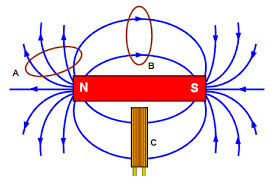Magnetic fields fill the space around all magnets, yet they’re impossible to discover with our very own detects. We’ll make use of an usual tool to map out an electromagnetic field and then talk about ferromagnetic materials to see how a magnetic field strength could be used to produce new magnets.
Detecting a Magnetic Field with a Compass
It’s a typical misconception that a compass is just a device for revealing you the direction you’re goinged. A compass is really a magnetic field instructions detector. Now, doesn’t that sound fancy? The confusion comes from the fact that we usually use a compass to spot the instructions of Earth’s electromagnetic field as a method to recognize which method we’re directly the planet’s area. While this is an excellent useful usage for a compass, we’re going to perform a hypothetical experiment utilizing the compass to diagram the magnetic field lines of a gigantic bar magnet.

The term ‘magnetic field strength’ generally refers to the room around a magnet where various other magnets will experience a force. The problem is we can not sense the electromagnetic field with our own senses, so we have to utilize a compass to help us ‘see’ the field. A compass is nothing more than a little magnet put on hold such that it could openly rotate in feedback to a magnetic field. Like all magnets, the needle has a north post and a south pole that are enticed as well as repelled by the posts of various other magnets. When the compass is positioned in a solid magnetic field, the forces of attraction and repulsion transform the needle up until it is completely aligned with the instructions of the area.
For our experiment, we’re visiting imagine that we have a bar magnet the dimension of a college bus sitting in a large open area. This need to aid you imagine perambulating the magnet and also ought to convince you that we’re handling a very strong electromagnetic field! With the compass in hand, we’ll start next to the north post as well as observe the orientation of the needle. Just what we would certainly see is that the needle points right out and also away from the magnet. If we started strolling in the instructions that the needle was pointing, we would certainly discover that as we acquired further away from the pole, the needle would start to turn to the side. Remaining to comply with the needle, we would ultimately stroll right around the magnet and come to the south pole. Below, the needle would point straight into the magnet. Attracting the path that we strolled would certainly offer us a layout that looked something like this.
If we repeated this experiment numerous much more times, but starting from somewhat different areas, our layout would at some point resemble this. Each one of the lines is called a field line, and also it reveals the direction of the electromagnetic field at various locations around the magnet. This diagram informs us a few different factors. First, it reveals us that the instructions of the magnetic field is constantly thought about to be coming out of the north pole and going into the south pole. This is truly simply a convention, however one that is widely followed. The second thing to observe is that the spacing of the lines suggests the toughness of the magnetic field. We could see that the area lines are most closely spaced near the posts of the magnet (where the field is greatest) as well as spread farther apart as we relocate far from the posts. If you’ve ever played around with magnets, you’ve probably really felt just how much the force between two magnets adjustments as the poles obtain closer as well as closer with each other.
Ferromagnetic Materials
The majority of magnets do not begin as magnets at all, but rather became one after being subjected to a magnetic field. Materials that could come to be magnets concern an unique team referred to as ferromagnetic materials, that includes iron, nickel as well as cobalt.Ferromagnetic products have atoms that themselves are magnetic, but just what makes them distinct is that the atoms team together right into magnetic domain names. Within each domain name, the atoms are straightened such that their magnetic fields merge to make the domain name itself act like a magnet. However, if the domain names throughout the material are arbitrarily oriented, then the product will certainly not behave as a magnet.
